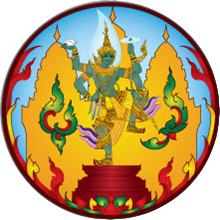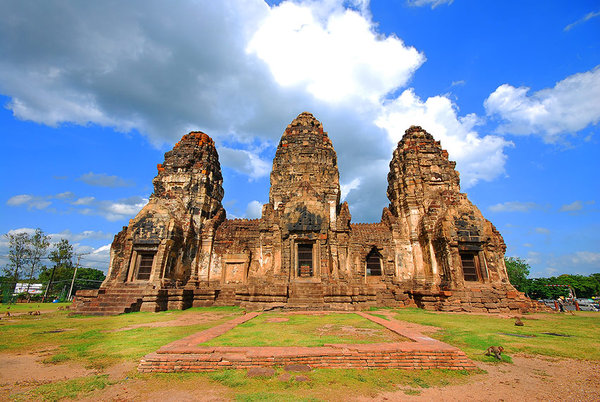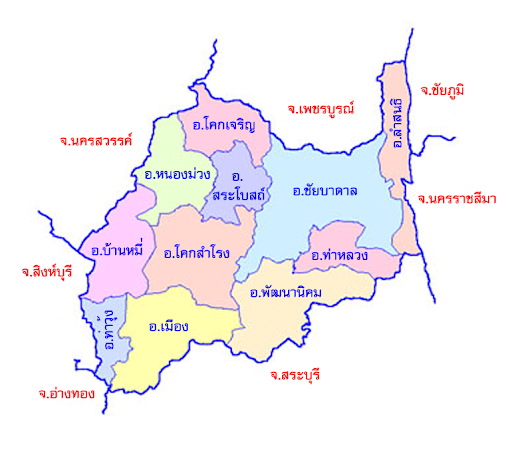
Provincial seal : It is a picture of Narayana standing on a pedestal in front of a three-spire prang.
Meaning : To honor King Narai the Great who established Lopburi as the capital city in 1665 and brought infinite prosperity to the land of Lopburi. The shape of the three-spire prang is an ancient site that is considered a symbol of Lopburi.

Lopburi provincial motto : Narai Palace, the city's twin palace, Phra Kan Shrine, the famous three-spire prang, the city of chalk , the famous Pasak Cholasit Dam, the golden land of King Narai
Meaning : It is a slogan that shows important places, important historical sites of Lopburi Province, including Phra Narai Ratchaniwet, Phra Kan Shrine, Phra Prang Sam Yot. It is a province that has made chalk since ancient times, and it is the best chalk in Thailand. It is the city that has the greatest prosperity in every aspect or what is called the Golden Age, which is during the reign of King Narai the Great.

Bullet Wood : Scientific name Mimusops elengi Linn.
Characteristics : A tree 10-20 meters tall with a dense crown. The bark is grayish-brown. The leaves are alternately arranged. The leaf blades are ovate to lanceolate, 2-5 centimeters wide and 5-10 centimeters long, with a tapering tip. The flowers are white mixed with yellow and have a fragrant smell. They bloom at the leaf axils and bloom throughout the year. The fruit is oval with a pointed tip, approximately 1.8 centimeters wide and 3 centimeters long. The ripe fruit is orange in color, with yellow flesh and a sweet taste. It contains 1 seed. It is grown as an ornamental plant and to provide shade. It is propagated using seeds.

Lopburi Province Map
History of Lopburi Province : Lopburi is a city with a long history because there are traces of human habitation since the prehistoric era, no less than 3,000-4,000 years ago from the discovery of a large amount of archaeological evidence and there is documentary evidence and inscriptions mentioning Lopburi in many ways, for example in the 11th-15th Buddhist centuries , there is evidence, namely the Northern Chronicles, mentioning that Phraya Kanwarndis sent a Brahmin army to build the city of Lavop since 1002 BE.
There is also the Chinkalamaliphakorn legend that mentions the establishment of Hariphunchai city in 1204 CE. Two years later, in 1206 CE,an envoy was sent down the Ping River to Lavapura city to ask for the descendants of the Lavapura king to rule. The Lavapura king then granted his daughter, Queen Chamadevi, to rule Hariphunchai city. The name of Lavapura city in the Chinkalamaliphakorn legend is accepted as the current Lopburi city. Therefore, it can be concluded that Lopburi must have been an important city. Other kingdoms accepted it and asked for descendants to rule.
During the period from the 16th to the 18th Buddhist century , Lavo or Lopburi occasionally fell under the authority of the Kingdom of Cambodia. Towards the end of the 18th Buddhist century , there was weakness in the Kingdom of Cambodia, causing the states that were once under its authority to become independent, including Lavo. In the 19th Buddhist century , evidence appeared that Lopburi was likely the city where King U Thong had ruled before moving to establish the Ayutthaya Kingdom.
It was during the Ayutthaya period that Lopburi flourished the most because King Narai the Great (reigned 1656-1688) established Lopburi as the second capital. After the reign of King Narai the Great, Lopburi lost much of its importance until the reign of King Rama IV of the Rattanakosin period, who established Lopburi as another place of residence. Therefore, it can be seen that Lopburi has been important for thousands of years.
 EN
EN TH
TH